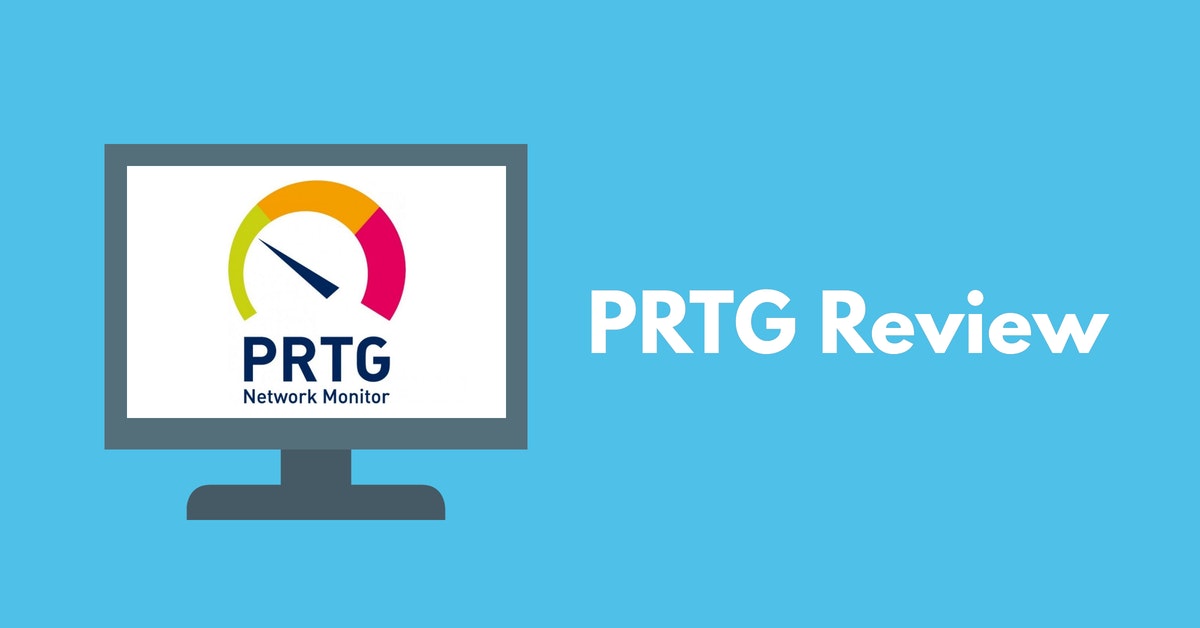

-
PROS
- Very extensible
- Deep support for most devices
-
CONS
- Sensor-based licensing can become expensive
- Requires dedicated, on-premises server
» Tổng quan PRTG và các sản phẩm chính
» Tính năng chính của phần mềm PRTG
» Tải dùng thử PRTG trong 30 ngày miễn phí
» Giới thiệu phần mềm PRTG Network Monitor
» PRTG Hosted Monitor – Giám sát hạ tầng CNTT trên đám mây hiệu quả
» PRTG Hosted Monitor – Đăng ký dùng thử
» PRTG Enterprise Monitor – Giám sát linh hoạt trong môi trường CNTT lớn
» Mua mới, nâng cấp bản quyền PRTG
» Mua gia hạn bản quyền PRTG
» So sánh PRTG với các phần mềm giám sát mạng khác
» Đăng nhập PRTG Portal
» Cấp phép PRTG
» Đối tác, đại lý PRTG
» Tải và cài đặt PRTG
» Các bài viết hỗ trợ sản phẩm PRTG
PRTG Network Monitor from Paessler AG is a mature and well-known workhorse in the network monitoring arena that starts at $1,750 for a perpetual license covering 500 sensors (more on that below). If you can get past the licensing scheme, this is an excellent management platform that’s squarely designed for IT professionals who know not only what they’re doing but also what they’re managing. It’s got great feature depth, device support, and it’s even user friendly, all of which earns it our Editors’ Choice designation along with fellow competitor, Ipswitch WhatsUp Gold.
EXCELLENT (4.5)
Plans and Pricing
Paessler has a somewhat unique licensing scheme for PRTG as it’s calculated on a “per-sensor” basis. A sensor is defined as a single metric on a device. For instance, if you’re managing a big switch, that sensor could be measuring network health status or whether the switch’s CPU utilization is running above 90%. As you can imagine, even administering a midsized network this way can get expensive quickly depending on how much information you want to see. That’s evident from Paessler’s pricing page, which though it starts at $1,750 for 500 sensors runs all the way up to $15,500 for an unlimited number of sensors.
If you’d rather stick to something with device-oriented licensing, our other Editors’ Choice, WhatsUp Gold is a better fit. Additionally, Paessler also charges more for support, which requires an annual renewal after the first year. For 24 months, there is a $360 charge; for 36 months, the price goes up to $680.00. This gives you access to bug fixes and premium email support. If you’d like to evaluate PRTG before deciphering its licensing, there is a free 30 day trail available for download on their website.

Installation and Configuration
Installation is the next little hiccup because PRTG requires some horsepower. Unlike most of the competition in this roundup, there’s no cloud service deployment model for PRTG. To run this monitoring tool, you’ll need access to a Microsoft Windows Server machine with at least 2 CPU cores and 3 gigabytes (GB) of RAM. You’ll also need at least 250 GB of disk space available. Yes, you can install it on a virtual machine, but that still won’t get you service from the cloud because Paessler recommends the software be installed on physical hardware that’s running inside the production environment being monitored for performance reasons.
For those looking to manage enterprise-sized networks with multiple locations, this can become a little more complicated. For these scenarios, the company recommends installing physical PRTG Remote Probes, which are also servers that each require at least one dual core CPU and a minimum of 2GB of RAM.

Managing Devices
Despite the local installation, PRTG uses a modern browser-based interface. While it’s a step above stodgier products, like Nagios XI, it’s not quite as nice to look at as IPSwitch Whatsup Gold. That said, it’s not only highly functional, it also makes it easy to find where you need to go. The one visual exception to the otherwise graphically lackluster interface is the clear attention to detail that has gone into creating network maps. In a word, these are beautiful. But, while they can be visually impressive, there’s a relatively steep learning curve you’ll need to eat before you can build one. But if you put in that effort and add a little practice, you’ll soon be able to build a gorgeous and very detailed map that you can throw up on a big screen TV in your NOC so everyone has a high-level overview of how your network is doing at any given time.
Managing individual devices is where PRTG’s strengths start to really show. The first thing you need to do before adding a device is set up all your credentials. This is a pretty standard step for all agentless monitoring tools since the server must reach out and communicate with systems remotely. Once that’s done, everything else is a cinch. To add a single device, go to Devices and Add Device. From there, supply an IP address, pick the type of device you’re adding, and then select whether you want it to autodetect the relevant sensors you might want to use. That’s it. Autodiscovery is simple to use if you’d rather go that way. Each device category shows up in a tree structure. Just click auto-discover and it immediately goes to work populating devices. Sensors can be added under each discovered device. I found this to be far more simple and elegant than any of auto-discovery method I tested this time around.
For those running virtual environments, know that PRTG can also monitor software-defined infrastructure and networks in either VMWare and Microsoft Hyper-V environments. You can add both the hosts and also have the system autodetect the virtual machines. Assuming that you have provided all of the credentials for your virtual machines, setting it up can be very close to a one click operation.

Alerts and Plugins
Notifications are set up on the sensors. These can be inherited by the parent groups or specified individually for that sensor. There are three layers of escalation you can configure but all are time-based. If the notification isn’t acknowledged during the first timeframe, the next person in line is notified. Email is the default notification method, but there are also options for SMS, Slack, Microsoft Teams, event logs, syslog messages, and SNMP traps, as long as you’re willing to take the extra steps to set them up. Most admins will likely be satisfied with email and SMS, but it’s nice to know that the functionality is there for the more advanced users. The fact that those options exist, means PRTG has potential for use an integration point for large ticketing systems and similar applications.
Like Nagios, PRTG has a significant number of plugin scripts developed by Paessler employees as well as PRTG users. The company maintains solid learning resources on its site as well as a healthy user community. Developing your own script isn’t for beginners, but Paessler has made sure to support a wide variety of development languages, including C#, Python, PowerShell, JavaScript, and Visual Basic. But before you start coding away, remember that because the model is so open, there is a high probability that if you’re looking to monitor something specific, someone else has already scripted for that need. If they’re willing to share, you’ll be able to find it on Paessler’s PRTG Script World website. Keep in mind, however, that plugins are considered sensors, so you’ll need to make sure you have enough room in your licensing for any new plugins you want to use.

Configuring Reporting
For such a highly functional product, and one that charges based on metrics no less, I didn’t find PRTG’s reporting module to be all that pretty. However, it’s certainly useful, allowing you to define custom reports or simple take advantage of the eight pre-configured ones. Your decision will likely mostly come down to picking a style and then the fields you want to show. Ultimately, it’s not very exciting, but it’ll definitely satisfy any manager’s need for paperwork.
While we were a bit taken aback at the licensing and not overly impressed with the prettiness of the interface, once we were using it we found PRTG to be a phenomenal product. IT professionals will not only find the monitoring features they’re looking for, but PRTG’s open architecture means an endless supply of device monitoring support through included, custom, and third-party plug-ins and add-ons. And though its network mapping function means devouring some learning assets, once you do that you’ll find these are very valuable even for day-to-day monitoring.
Paessler PRTG Network Monitor Specs
| Device Discovery | No |
| Agentless | Yes |
| Traffic Monitoring/Packet Inspection | Yes |
| Email/SMS Alerting | Yes |
| Patch Management | Yes |
| Real-Time Alerting | Yes |
| Mobile Device Support | Yes |
| On-Premises Deployment | Yes |
| Application Programming Interface (API) | Yes |
| Custom Dashboards | Yes |
| Custom Reporting | Yes |
more recommended stories
 So sánh các gói Microsoft 365 Business bản quyền dành cho doanh nghiệp
So sánh các gói Microsoft 365 Business bản quyền dành cho doanh nghiệpNền tảng hoạt động phần mềm.
 So sánh gói phần mềm Microsoft 365 for frontline workers F1, F3, F5
So sánh gói phần mềm Microsoft 365 for frontline workers F1, F3, F5Microsoft 365 for frontline workers là.
 Hướng dẫn chi tiết về các loại cấp phép Microsoft 365 & Office 365
Hướng dẫn chi tiết về các loại cấp phép Microsoft 365 & Office 365Tìm hiểu các loại cấp phép.
-
Làm thế nào để mua Microsoft Enterprise Mobility + Security bản quyền
Trong thế giới kỹ thuật số.
 So sánh Microsoft Defender for Business và Defender for Endpoint
So sánh Microsoft Defender for Business và Defender for EndpointMột trong những công thức lớn.
 So sánh Adobe Acrobat Pro vs. Acrobat Pro 2020: Tại sao nên chuyển sang gói đăng ký?
So sánh Adobe Acrobat Pro vs. Acrobat Pro 2020: Tại sao nên chuyển sang gói đăng ký?Acrobat Pro là giải pháp PDF di.
 So sánh Adobe Premiere và Photoshop Elements 2023
So sánh Adobe Premiere và Photoshop Elements 2023Không còn phải mất quá nhiều.
 So sánh tính năng, thành phần giữa Adobe Creative Cloud dành cho Teams và Enterprise
So sánh tính năng, thành phần giữa Adobe Creative Cloud dành cho Teams và EnterpriseLàm việc trong các lĩnh vực.
